Jacksonville, FL, is known for its incredible wildlife, offering more than just a bustling city experience. While you might expect to see whales, dolphins, and sharks along the coastline or catch a glimpse of bald eagles and ospreys soaring in the sky, another much smaller creature calls this city home: spiders. They might not be as majestic as alligators or as playful as otters, but spiders are an integral part of Jacksonville’s ecosystem.
In this article, we will uncover the different types of spiders that call Jacksonville home. From the shy ones hiding in corners to the dangerous ones spinning webs in your backyard, let’s dive into the captivating lives of Jacksonville’s spiders!
Venomous Spiders in Jacksonville
Watch out for the following venomous spiders in Jacksonville!
1. Brown Recluse Spider (Loxosceles reclusa)
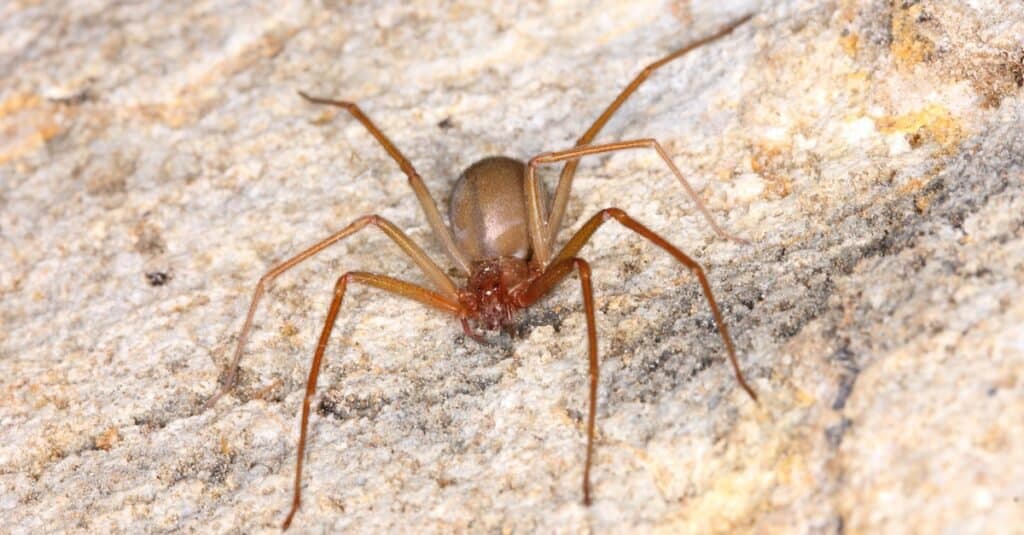
One of the most dangerous spiders you’ll come across in Jacksonville, FL, is the brown recluse spider.
©Pong Wira/Shutterstock.com
Brown recluse spiders are not originally from Florida. Still, they have been found and sometimes form colonies in Jacksonville. One of these is the brown recluse.
Typically, a full-grown brown recluse is about as big as a U.S. quarter when you include its legs. These spiders have a uniform tan to dark brown color, and their abdomen and legs are solid-colored without any patterns. Their legs are slender and don’t have noticeable spines or hairs.
Brown recluse spiders usually choose to live in small openings found under rocks, wooden planks, or dead tree bark. These spiders like warm, dry places to set up their nests. Their diet comprises soft insects like crickets, roaches, moths, and flies. Interestingly, they’re known to eat each other too.
Instead of trapping their food in webs like some spiders do, brown recluses hunt at night.
While their venom is highly toxic, it generally doesn’t cause severe harm to humans because they inject so little of it. With that said, the venom contains an enzyme that damages blood vessels and causes nearby cells to die. So, it’s best to avoid this spider if you see it!
2. Southern Black Widow (Latrodectus mactans)
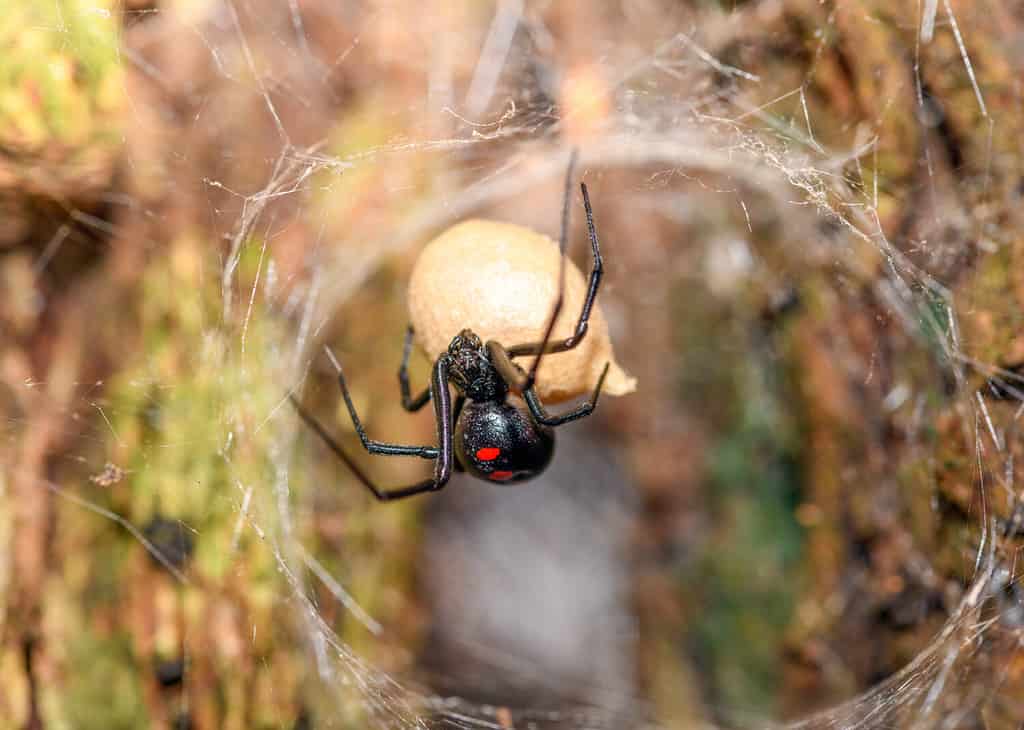
Southern black widows are another dangerous and venomous spider species you should look out for in Jacksonville.
©Jeff W. Jarrett/Shutterstock.com
Four types of black widow spiders have made Florida, including Jacksonville, their home. The most notable among them is the southern black widow. The name “black widow” comes from the fact that these spiders eat their partners after mating.
Female southern black widows have glossy black bodies adorned with red spots on their round abdomen’s upper side. And on the underside of their abdomen, these spiders also have that famous red, hourglass-shaped marking. In contrast, male spiders have flatter abdomens featuring red and white spots.
Females measure between 0.31 and 0.5 inches in body length and can reach up to 1.37 inches when you count the legs. Males are significantly smaller in size.
You’ll usually find these spiders outdoors in places like stacks of wood or rocks, rodent holes, and empty tree trunks. However, they also visit less-frequented areas like garages, sheds, and basements. Their diet mainly consists of bugs such as ants, caterpillars, grasshoppers, and beetles.
While black widow venom is extremely potent, an initial bite might not hurt much. The real pain sets in an hour or two later. Some people might even experience nerve-related tingling or discomfort down their spine. Other symptoms include muscle spasms, intense pain, perspiration, convulsions, and nausea.
3. Red Widow (Latrodectus bishopi)

An interesting and uncommon spider species that may occasionally wander into Jacksonville is the red widow.
©Florida Division of Plant Industry Archive / CC BY 3.0 US, via Wikimedia Commons – License
The red widow spider is native to certain regions in Florida.
Its physical features include a black abdomen, along with a head, thorax, and legs that are reddish-orange in color. This spider usually exhibits a few tiny red marks on its back, each surrounded by a white border.
Female red widows are around half an inch in size and have a leg span that varies between half an inch and two inches. Males are considerably smaller in comparison.
These spiders are exclusive to sandy, dry landscapes like Florida’s scrub and flatwoods. They primarily feed on large insects like crickets and flies but have a special liking for scarab beetles.
Like their black widow counterparts, red widows are venomous. The venom from a female red widow is particularly harmful to humans, causing ongoing muscle spasms. On the other hand, males pose less of a risk as they generally don’t bite people.
4. Brown Widow (Latrodectus geometricus)
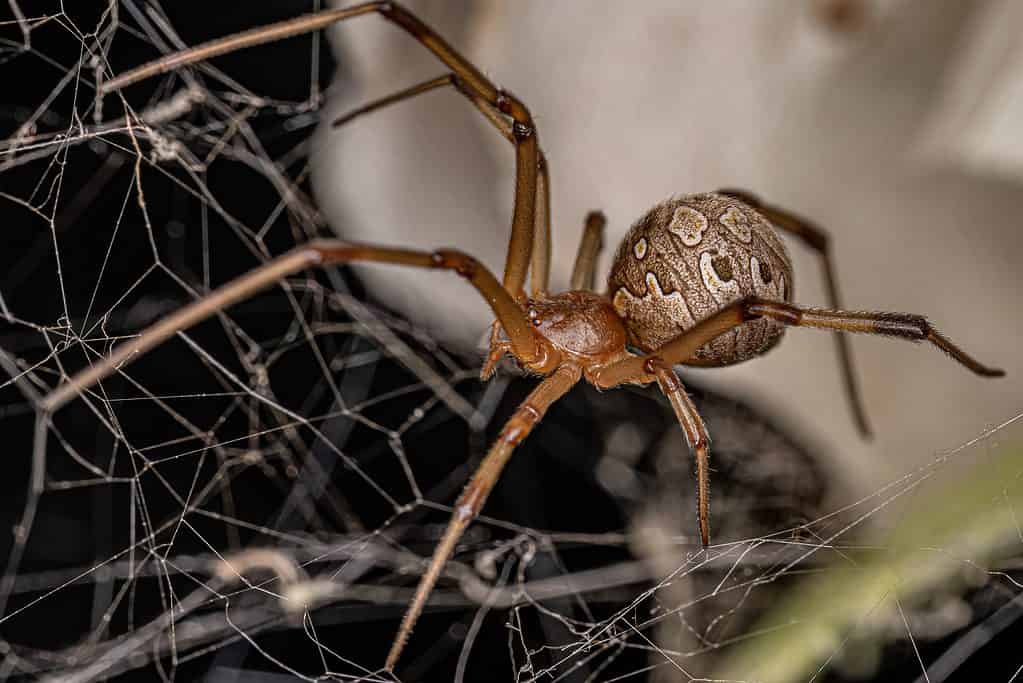
Just like other widow spider species, the brown widow has a rounded abdomen and females are larger than males.
©Vinicius R. Souza/Shutterstock.com
Another venomous spider you’ll find in Jacksonville is the brown widow.
While black widows are primarily black and red, brown widows have a mix of tan, brown, and black colors. Mature females often display a single stripe running down their abdomen, as well as three angled lines on each side.
Female brown widows are typically between 1 and 1.5 inches long when their legs are extended, whereas males are noticeably smaller.
These spiders prefer to make their homes in quiet, sheltered spots near houses or in trees and bushes.
Brown widow spiders mostly eat insects and anything they manage to catch in their webs. They use sticky silk to trap their prey and then inject venom before eating them.
While brown widows are venomous like their black widow relatives, they’re generally less harmful to humans. Even though their venom is equally potent, brown widows release a smaller amount when they bite. It’s worth mentioning that only mature female brown widows pose a biting risk; young and male brown widows don’t bite at all.
5. Northern Black Widow (Latrodectus variolus)
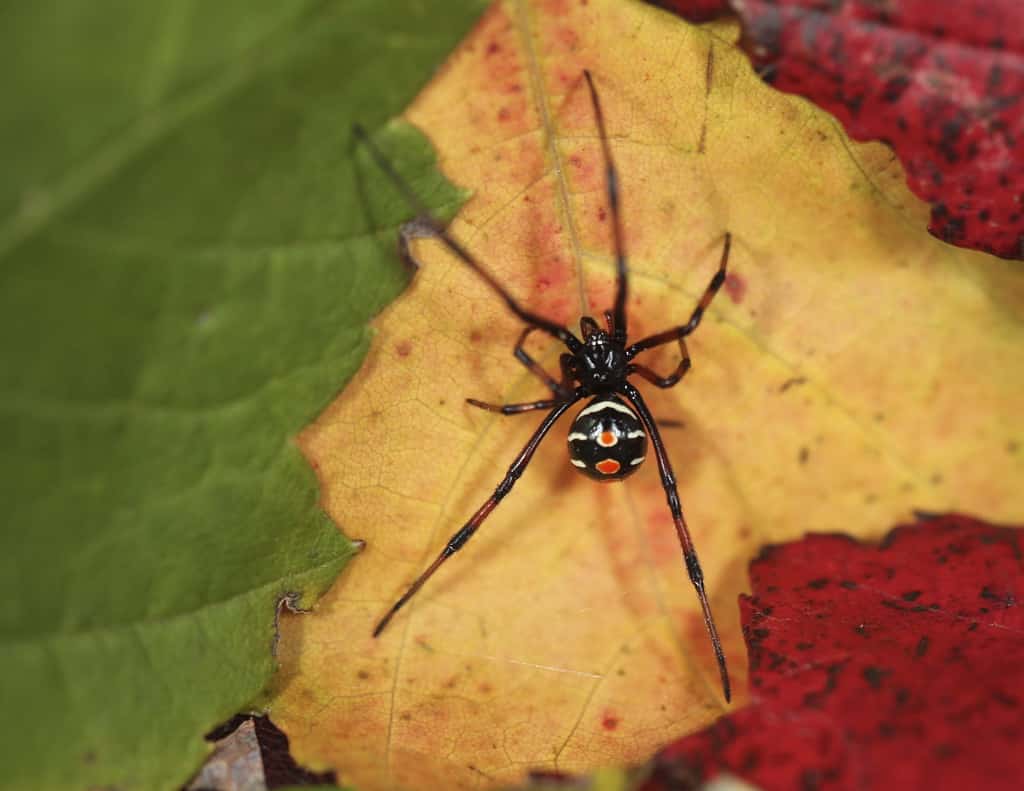
The final spider species you should look out for in Jacksonville is the northern black widow.
©iStock.com/NajaShots
The northern black widow is found all over Florida and is notorious for being venomous.
These spiders have shiny black bodies and a unique red marking shaped like an incomplete hourglass on the bottom of their abdomen. The marking can also vary with age, sometimes featuring a series of reddish-orange spots on the top of the abdomen.
Female spiders have a body about half an inch long, or 1.5 inches when you include their legs. As with other widow spider species, males are smaller in comparison.
These spiders construct intricate three-dimensional webs, and they prefer dark, enclosed areas with plenty of anchor points for their webs. Man-made structures like stone walls, culverts, and woodpiles can also serve as habitats for northern black widow spiders.
They are skilled predators that primarily feed on live insects, other spiders, arthropods, and even other members of their own species.
Like the other black widows we’ve discussed, the northern black widow is also venomous. However, it’s worth noting that their timid nature makes them shy, and they rarely bite humans. Nonetheless, it’s always essential to exercise caution when encountering these venomous spiders.
Non-Dangerous Spiders in Jacksonville
Let’s look at some of the common non-venomous spiders in Jacksonville.
6. Carolina Wolf Spider (Hogna carolinensis)
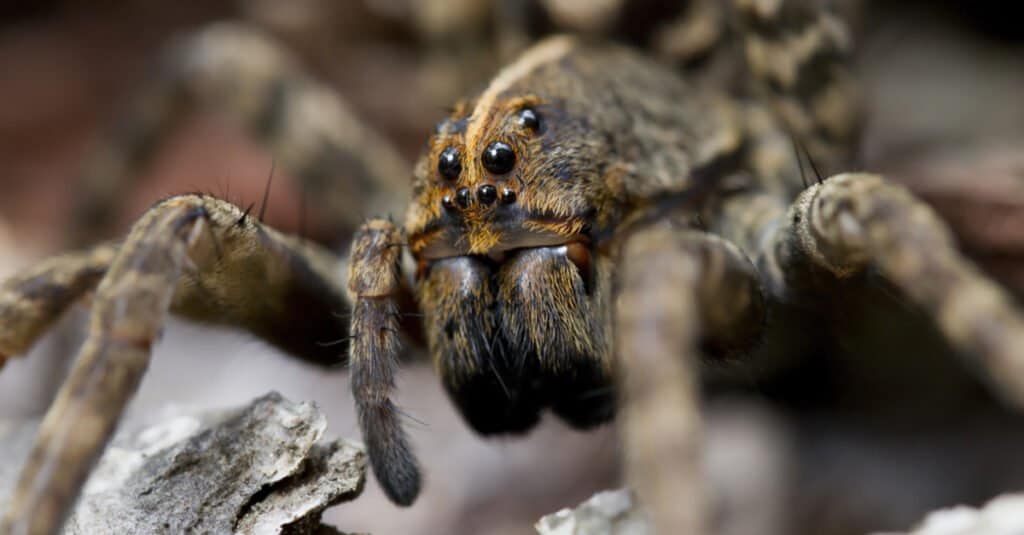
Although the Carolina wolf spider may look super dangerous, these spiders are harmless to humans.
©Will E. Davis/Shutterstock.com
The Carolina wolf spider is among the largest spider species you’ll find in Jacksonville and the United States.
Measuring between 3 and 4 inches, it has a unique eye configuration with eight eyes in total: four small ones on the bottom row, two large ones in the middle, and a final pair of medium-sized eyes on the top row. They could be brownish-gray or medium brown in color.
Instead of weaving webs like many other spiders, Carolina wolf spiders dig burrows in the ground. Their natural habitats include dry, bushy areas, coastal woodlands, and even neighborhood gardens. They primarily feast on insects that are ground-dwellers, including beetles, grasshoppers, and cockroaches, as well as other spiders.
While their size might seem threatening, Carolina wolf spiders are generally harmless to people. An allergic reaction to their venom is possible but rare, and they aren’t poisonous. A bite could be painful due to the spider’s size, but any discomfort, like mild pain or brief swelling and itching, usually resolves quickly. Generally, a bite from a Carolina wolf spider is no more dangerous than a bee sting, so no need to worry despite its menacing look!
7. Bold Jumping Spider (Phidippus audax)

Both cute and scary at first glance, the bold jumping spider is a non-venomous spider species you may come across in Jacksonville.
©Brett Hondow/Shutterstock.com
Jumping spiders are a frequent sight in Jacksonville. Of the many jumping spiders that call Florida home, the bold jumping spider stands out.
These small, fuzzy arachnids have black bodies adorned with tiny white hairs. Their main body is elevated, rounded, and robust, while their abdomen displays unique markings. Notably, they have a large white triangle in the center of their abdomen, flanked by two smaller spots. One of their most eye-catching traits is their set of eight eyes. One pair of eyes is noticeably large, giving them a more humanoid look. In terms of size, these tiny spiders are only 0.5 inches in length.
You’ll often find these agile spiders in various outdoor settings, from open fields and meadows to forests and farmlands.
These solitary hunters have incredible vision, which they use to hunt. Their diet is quite diverse, including insects like caterpillars and dragonflies, as well as grasshoppers and even other spiders.
Despite their somewhat intimidating look (when magnified), jumping spiders pose absolutely no threat to people. They aren’t venomous, so there’s no need to worry if you encounter one.
8. Spiny Orb Weaver (Gasteracantha cancriformis)

Spiny orb weaver spiders are very recognizable due to their unique look.
©SIMON SHIM/Shutterstock.com
In addition to wolf and jumping spiders, various types of orb weavers also call Jacksonville home. Of these, the most notable spider is the spiny orb weaver.
These spiders are easily recognized by their six needle-like extensions on their abdomen. These extensions are commonly referred to as spines. Their bodies and legs are primarily black in color, adorned with white markings on their abdomen’s underside. Typically, in Florida, the top side of their abdomen is white with black dots and red, spiky spines.
Spiny orb weavers can range in size from 0.06 inches to 0.38 inches.
You’ll often spot these unique spiders hanging out on trees and bushes near homes or in plant nurseries, especially in areas with citrus trees. Their main source of food consists of small insects that get trapped in their intricate webs.
Orb weavers are harmless to people. While they do technically have venom, it’s not potent enough to affect humans; it’s really only effective for subduing their tiny prey.
9. Common House Spider (Parasteatoda tepidariorum)
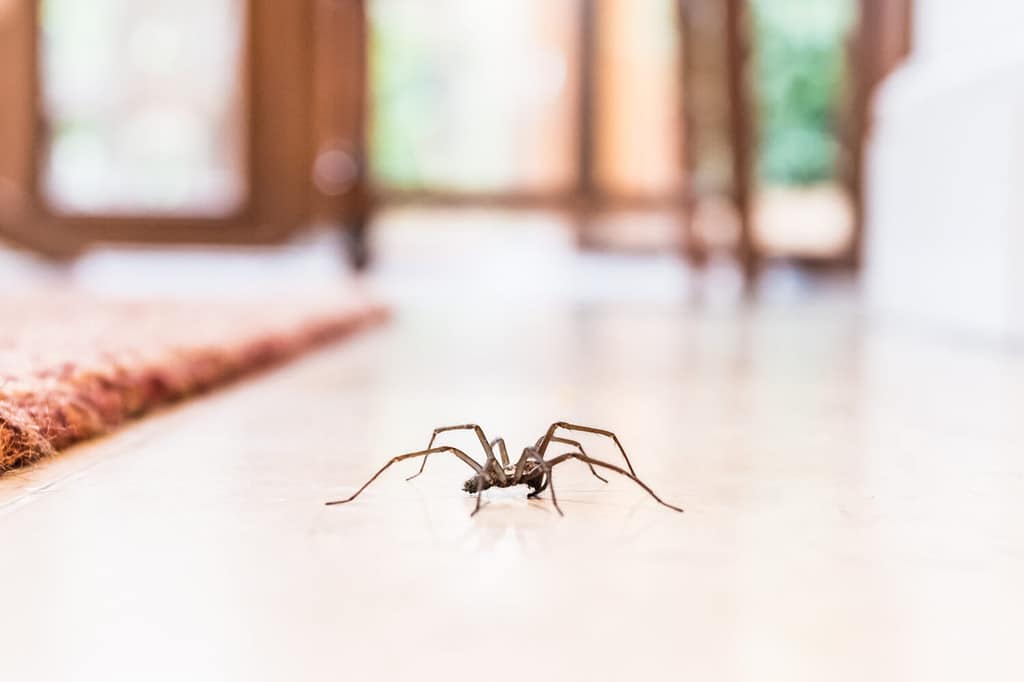
One of the most common spiders you’ll encounter in Jacksonville is the common house spider.
©Christine Bird/Shutterstock.com
The common house spider is a familiar sight across the entirety of the United States, including in Jacksonville.
These spiders are usually brown in color, though some may feature brown or white marks on their belly area. Male house spiders have legs with a hint of orange, while females have yellowish legs. The legs often display distinctive dark bands.
Common house spiders measure less than a quarter-inch across. And, as is the case with your average spider species, female house spiders are bigger than their male counterparts.
You’ll find these spiders in a huge variety of places, from gardens and yards to indoor spaces like basements and attics. They’re also frequent visitors in buildings like barns and sheds. They primarily eat insects found around the home, such as flies, ants, and mosquitoes.
While technically venomous, these spiders do not pose any threat or danger to humans since their venom only affects their prey.
10. American Nursery Web Spider (Pisaurina mira)
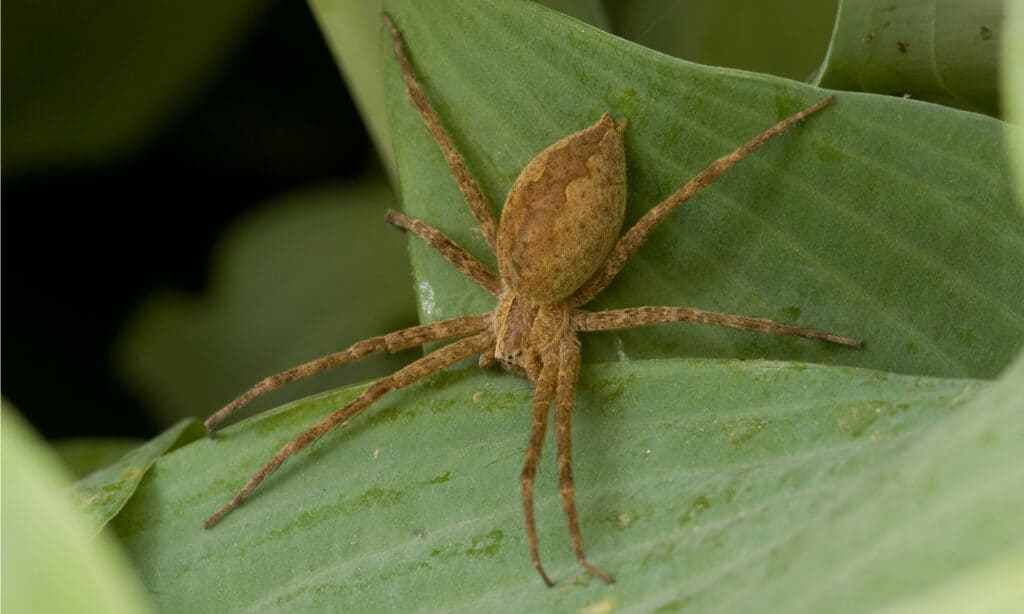
The American nursery web spider is often mistaken for the Carolina wolf spider, and it’s easy to see why.
©SDeming/Shutterstock.com
In Jacksonville, American nursery web spiders are frequently mistaken for their look-alikes, the wolf spiders.
Male nursery web spiders are about a third of an inch long, whereas females can grow nearly three-quarters of an inch. This figure does not include their sizeable legs. They often sport two noticeable, dark stripes on the front half of their bodies. The color of these spiders can range from a faint yellow to a rich, reddish-brown hue, and their lifespan is generally around one year.
Unlike the spiders you may be used to around your home, American nursery web spiders are on-the-move hunters, commonly seen near plant life or close to water sources. They’re found in both wooded and meadow areas. However, they are particularly abundant in spaces where the woods transition into fields. Their meals mainly consist of small insects like flies, mosquitoes, and even tadpoles!
While these spiders may appear daunting due to their larger size, nursery web spiders pose no significant threat to either people or animals. On the contrary, they serve as valuable predators of various insect nuisances in outdoor spaces like gardens and farms. With that said, American nursery spiders do technically have venom, but it is not strong enough to pose any threat to us humans or even our pets.
Summary of the Spiders Crawling Around Jacksonville
| Number | Spider | Scientific Name | Venomous? |
|---|---|---|---|
| 1. | Brown Recluse Spider | Loxosceles reclusa | Yes |
| 2. | Southern Black Widow | Latrodectus mactans | Yes |
| 3. | Red Widow | Latrodectus bishopi | Yes |
| 4. | Brown Widow | Latrodectus geometricus | Yes |
| 5. | Northern Black Widow | Latrodectus variolus | Yes |
| 6. | Carolina Wolf Spider | Hogna carolinensis | Yes, but not dangerous to humans |
| 7. | Bold Jumping Spider | Phidippus audax | No |
| 8. | Spiny Orb Weaver | Gasteracantha cancriformis | Yes, but not dangerous to humans |
| 9. | Common House Spider | Parasteatoda tepidariorum | Yes, but not dangerous to humans |
| 10. | American Nursery Web Spider | Pisaurina mira | Yes, but not dangerous to humans |
The photo featured at the top of this post is © Jeff W. Jarrett/Shutterstock.com
Thank you for reading! Have some feedback for us? Contact the AZ Animals editorial team.







